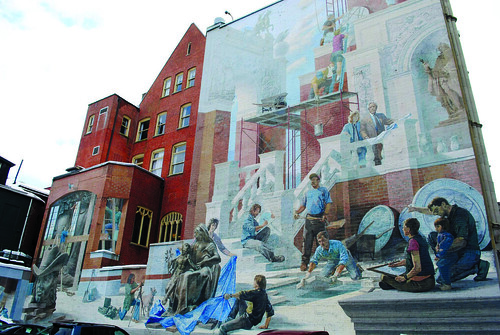Ryan Derfler spills the paint on his job as a MAP guide.

Through the City of Philadelphia Mural Arts Program’s Albert M. Greenfield Restorative Justice program, Philadelphia prisoners are painting the wounds and broken pieces of the city back together into a mosaic, one stroke at a time.
Crime covers Philadelphia, literally, as city inmates paint murals through Restorative Justice, a program that allows select Philadelphia inmates to help MAP complete murals throughout the city.
The program can serve as a way for participants to be involved in the lives of their children and neighbors, and for many inmates, the murals represent a medium through which they can connect with loved ones and family members.
Ryan Derfler is the touring manager for MAP. One of the most moving experiences he has ever had, he said, came when he had a conversation with a Philadelphia inmate who had been sentenced for life. When Derfler asked the prisoner how he felt about Restorative Justice, the prisoner said it was the only thing he would ever do that would let him see the light of day.
“Poor people in Philadelphia are forgotten,” Derfler said. “The United States has more people in jail than any other country. The poorest neighborhoods have no art programs. [Restorative Justice] creates room for openness and expression.”
Derfler, a self-described “fast-moving, hit-the-ground-running sort of guy” with a passion for art and Philadelphia, earned a minor in art from Lebanon Valley College and studied the Italian Renaissance in Italy. Later, he developed a passion for sales and corporate event planning, and finally, he combined all these passions when he became part of the nonprofit.
“Philly is on the verge,” he said. “It has unlimited potential, especially in the arts and culture scene. I’m glad to be a part of it.”
MAP has completed more than 2,800 murals throughout the city. There is a waiting list of 2,000-plus applications for future murals. To complete all the murals that have been requested, it would take MAP’s 300 artists as long as a decade.
Murals can have a huge impact on the neighborhoods they are painted in. When a new mural is commissioned, community members often come out to clean up the area, removing litter, mowing grass, clearning sidewalks and repainting fences. Weeds, broken glass and other garbage once strewn across abandoned lots can be cleared to reveal lively open spaces.
Derfler said he feels the murals create a community dialogue that is long forgotten. The murals become a positive tool for social change, he said, as an industrial economy in Philadelphia shifts to an informational and creative one.
Matt Flocco can be reached at matthew.flocco@temple.edu.



Be the first to comment